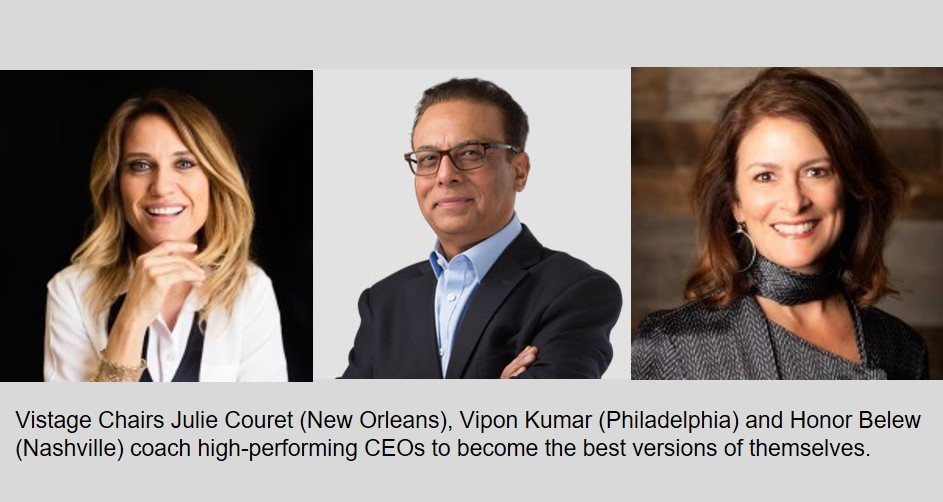A week in the life of a Vistage Chair CEO coach

Each Vistage Chair has their own reason for wanting to help executives become excellent.
After a health scare, Vipon Kumar realized that he wanted to help people in their careers, just as he had been helped. “Everywhere I worked, there was somebody who helped me,” said Kumar, a Vistage Chair near Philadelphia. “Multiple people who didn’t know me offered me help. They did not expect anything back from me.”
Now, Kumar leads a group of talented executives. In the past year, he’s helped each member of his group reach double-digit growth in their business.

Julie Couret, an executive coach and Vistage Chair in New Orleans, always wanted to start her own group coaching, but lacked the resources. With Vistage, she feels that she has the support, resources, and ongoing education to properly lead a group of successful executives.
“Vistage brings the experience that I cannot create as an individual,” Couret said.
Honor Belew, a Vistage Chair in Nashville, loves being a servant leader, giving CEOs feedback they can’t typically get from within their own business.
“Very often, business owners and CEOs don’t really have anyone to talk to who’s unbiased,” Belew said. “I do a lot of listening. I ask questions and we identify the most important issues they need to resolve so that they can move forward.”
No matter the reason for becoming a Vistage Chair, each feels a duty to help their group of CEOs become the best versions of themselves.
Here’s how Kumar, Couret and Belew lead their Vistage groups.
One-to-one meetings
Every week, Vistage Chairs meet individually with members of their group. This is time to ask questions and identify the executive’s most important issues, Belew said. More importantly, this is a time where she can push members outside of their comfort zone.
“I challenge them,” Belew said. “And when I challenge them, they thank me for challenging their thinking, because they don’t often get challenged in their roles.”
Challenging executives helps them figure out what’s truly important, Couret said. What needs do they have? Why does it matter? What have they tried so far? By asking more questions, Couret said that the CEO can figure out their next move toward success.
The monthly meeting
There’s no better way to describe a Vistage meeting than “peer accountability.” Couret is amazed each month—the members lead each other. It’s her favorite part of being a Vistage Chair.
“We’re there to facilitate the conversation, guide them, and help them learn how to process issues,” said Couret. “In the group, the value comes from the contribution and the questions from each other.”
Kumar calls this part of Vistage meetings “care-frontation.” It’s a gentle push between the members. “They confront each other in the right way,” he said. “They care but they confront.”
Belew loves the energy of these meetings. “These are really driven executives with a thirst for growing and learning,” she said. “The meeting is about giving them the tools and perspectives they need to grow.”
Finding speakers
Vistage Chairs bring subject matter experts to meetings to educate their members on a variety of topics, both for the business and the individual leader.
Belew, Couret and Kumar all said that they survey their groups to see what speakers and subjects would give them the most value. Belew added that she gets great recommendations for speakers from other Vistage Chairs.
“I want to make sure that we’re getting the best possible speakers, and that my members are getting value,” said Belew.
Recruiting members
Vistage Chairs spend weeks figuring out what executives will best fit into their group. Each Chair has unique requirements for who is a good fit.
“My members have their sleeves rolled up,” Couret said. “We are being aggressive about our growth. We’re taking our businesses to the next level. My group is industry disruptors, they’re uniquely different and they’re successful.”
Belew looks for connection with potential members. She’s noticed she connects best with executives who are open, curious, humble and vulnerable. She also wants to bring in a diverse group—people of different ethnicities, gender and backgrounds can bring something unique to the group. “Respect, non-judgement and trust are non-negotiable,” she said.
Kumar meets extensively with each potential member and builds his group like a business. He invites members from different backgrounds, filling out niches like marketing, supply chain and finance.
“I consider myself a portfolio manager without equity in these 14 companies,” Kumar said.
Top-down improvements
Becoming a Vistage Chair is not a part-time endeavor, Kumar said. By running his group as a full-time business, he’s able to help expand the thinking and vision of his members.
“The objective is not to pass on my knowledge,” Kumar said. “The objective is to help members become better versions of themselves.”
Couret said that by pushing her members to become better executives, each business becomes better for the employees.
“It starts at the top and that’s why we work top-down,” Couret said. “We’re catching leaders at every angle. That’s what impacts business. That’s what keeps us being successful, happy and thriving—having a great place to work.”
Although being a Chair takes a lot of work, Belew loves being able to lead her group meetings and help CEOs improve.
“At the end of a meeting day, my husband said to me, ‘You’re so energized, I would think you’d be exhausted,’” Belew said. “It’s just so energizing being with these super smart, driven people and seeing what they want to achieve and what they are achieving.”
Category: Leadership
Tags: executive coaching, leadership development, Vistage Chair

